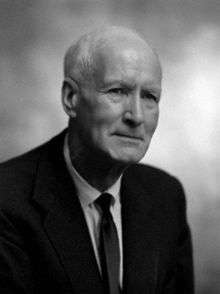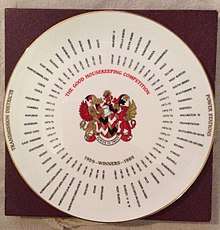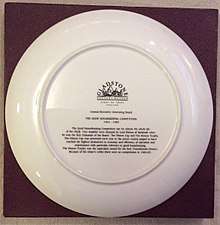Christopher Hinton, Baron Hinton of Bankside
| The Right Honourable The Lord Hinton of Bankside OM KBE FRS FREng | |
|---|---|
 | |
| Born |
12 May 1901 Tisbury, Wiltshire, England, UK |
| Died |
22 June 1983 (aged 82) London, England, UK |
| Nationality | British |
| Known for | Calder Hall |
| Awards |
Wilhelm Exner Medal (1956) Castner Medal (1956) Albert Medal (1957) Rumford Medal (1970) James Watt International Medal (1973) Order of Merit (1976) |
| Scientific career | |
| Fields | Nuclear |
Christopher Hinton, Baron Hinton of Bankside OM KBE FRS FREng[1] (12 May 1901 – 22 June 1983) was a British nuclear engineer, and supervisor of the construction of Calder Hall, the world's first large-scale commercial nuclear power station.
Career
Hinton was born on 12 May 1901 at Tisbury, Wiltshire. He attended school in Chippenham where his father was a schoolmaster, and left school at 16 to become an engineering apprentice with the Great Western Railway at Swindon. At 22 he was awarded the William Henry Allen scholarship of the Institution of Mechanical Engineers to Trinity College, Cambridge, where he graduated with a first class honours degree.[2]
Hinton then worked for Brunner Mond, later part of ICI, where he became Chief Engineer at the age of 29. At Brunner Mond he met Lillian Boyer (d. 1973) whom he married in 1931.[3] They had one daughter, Mary (1932–2014), who married Arthur Mole, son of Sir Charles Mole, director-general of the Ministry of Works.
During World War II, Hinton was seconded to the Ministry of Supply and became Deputy Director General, running ordnance factory construction and in charge of the Royal Filling Factories.[3]
In 1946, Hinton was appointed Deputy Controller of Production, Atomic Energy, and in 1954 when the Atomic Energy Authority was formed, was appointed Member for Engineering and Production as managing director of 'Industrial Group Risley'[3] which comprised the Risley headquarters and laboratories at Culcheth, Capenhurst, Windscale, Springfields and Dounreay plus factories at Springfields, Capenhurst, Windscale, Calder, Dounreay and Chapelcross.
Hinton's department was responsible for the design and construction of most of Britain's major nuclear plants, including Windscale, Capenhurst, Springfields and Dounreay. In 1957, Hinton became the first chairman of the Central Electricity Generating Board. He retired in 1964. In 1965 he worked for six months in the Ministry of Transport and afterwards became a Special Adviser to the World Bank. He served as Chairman of the International Executive Committee of the World Energy Conference, 1962–68.[3]
He was created Baron Hinton of Bankside, of Dulwich in the County of London, a life peer, on 28 January 1965, and served as Chancellor of the University of Bath 1966 – 1979.[4] He was appointed to the Order of Merit in 1976.[5]
Hinton Heavies
The English architectural critic Reyner Banham dubbed the first 500MW units ordered by the CEGB as the Hinton Heavies. A first for 500MW power station design the stations are listed below in the order that the CEGB released them for construction.[6]
| Power Station | County | Output (MW) | ||
|---|---|---|---|---|
| 01 | West Burton | Nottinghamshire | 2000 MW | |
| 02 | Ferrybridge 'C' | West Yorkshire | 2000 MW | |
| 03 | Eggborough | North Yorkshire | 2000 MW | |
| 04 | Kingsnorth | Kent | 2000 MW | Oil Fired |
| 05 | Fawley | Hampshire | 2000 MW | Oil Fired |
| 06 | Aberthaw ‘B’ | South Wales | 1500 MW | |
| 07 | Ironbridge 'B' | Shropshire | 1000 MW | |
| 08 | Fiddlers Ferry | Cheshire | 2000 MW | |
| 09 | Ratcliffe | Nottinghamshire | 2000 MW | |
| 10 | Cottam[7] | Nottinghamshire | 2000 MW | |
| 11 | Pembroke | South West Wales | 2000 MW | Oil Fired |
| 12 | Rugely 'B' | Staffordshire | 2000 MW | |
| 13 | Didcot 'A' | Oxfordshire | 2000 MW |
The Hinton Cup & Hinton Trophy
During his time at the Central Electricity Generating Board he commissioned the Hinton Cup, a piece of silverware that would be presented annually to the power station that displayed good housekeeping in the workplace. The citation to go with the cup reads 'This cup is presented to the Power Station judged to have reached the highest attainment in economy and efficiency of operation and maintenance with particular reference to attractiveness and good housekeeping'.
The cup was first won by Meaford A power station in 1959 and was last won by West Burton Power Station prior to the divestment of the Central Electricity Generating Board. The Hinton Trophy was the equivalent award for the best Transmission District. Because of the miners strike there was no competitions in 1984-85. To commemorate the thirty years of awarding the cup and trophy a presentation plate was manufactured by Gladstone Pottery Museum in Stoke-on-Trent. The Hinton Trophy was sold to a private buyer in Cuttlestones of Wolverhampton auction saleroom on the 11th October 2013.[8]


| Power Station | Year | Transmission District | |
|---|---|---|---|
| 01 | Meaford | 1959–1960 | |
| 02 | Stella North | 1960–1961 | Luton |
| 03 | South Denes | 1961–1962 | Bristol |
| 04 | Darlington | 1962–1963 | Durham |
| 05 | Marchwood | 1963–1964 | Nottingham |
| 06 | Rheidol | 1964–1965 | Bushbury |
| 07 | Huddersfield | 1965–1966 | Swansea |
| 08 | Poole | 1966–1967 | Taunton |
| 09 | Elland | 1967–1968 | East Riding |
| 10 | West Burton | 1968–1969 | Northumberland |
| 11 | South Denes | 1969–1970 | Leeds |
| 12 | Staythorpe | 1970–1971 | Poole |
| 13 | Thornhill | 1971–1972 | Stourport |
| 14 | Sizewell A[9] | 1972–1973 | Cumbria |
| 15 | Willington B[10] | 1973–1974 | Rayleigh |
| 16 | Trawsfynydd[11] | 1974–1975 | Bushbury[12] |
| 17 | Ratcliffe-on-Soar | 1975–1976 | Kings Lynn |
| 18 | Oldbury on Severn | 1976–1977 | East Cheshire |
| 19 | Keadby | 1977–1978 | Staythorpe |
| 20 | Fawley | 1978–1979 | Solent |
| 21 | Sizewell | 1979–1980 | Taunton |
| 22 | Eggborough | 1980–1981 | Southern |
| 23 | Cottam | 1981–1982 | Northwest (Midlands Region)[13] |
| 24 | Pembroke | 1982–1983 | Northwest (Midlands Region) |
| 25 | Drax | 1983–1984 | Northwest ( Northwest Region) |
| 26 | Thorpe Marsh | 1985–1986 | Northwest (Midlands Region) |
| 27 | Ratcliffe-on-Soar | 1986–1987 | Wealdon |
| 28 | Rugley A & B | 1987–1988 | Chase |
| 29 | West Burton | 1988–1989 | Westward |
Awards and achievements
- Knighted 1951[14]
- Fellow of the Royal Society 1954[1]
- Wilhelm Exner Medal, 1956
- Knight Commander of the Order of the British Empire, 1957[15]
- Fellow of Trinity College, 1957
- Honorary Degree (DSc), University of Oxford 1957
- Honorary Degree (ScD), University of Cambridge 1960
- On 28 January 1965 he was made a life peer as Baron Hinton of Bankside, of Dulwich in the County of London.[16]
- President of the Institution of Mechanical Engineers, 1966
- Foreign Associate, National Academy of Engineering, 1976
- Order of Merit, 1976[5]
- Honorary Degree (Doctor of Science), University of Bath, 1966[17]
- Chancellor of the University of Bath 1966–80
- James Watt International Medal 1973
- First President of the Royal Academy of Engineering
- DRS Class 37 diesel locomotive 37409 named Lord Hinton at Crewe Gresty Bridge Depot Open Day, 10 July 2010
| Academic offices | ||
|---|---|---|
| New institution | Chancellor of the University of Bath 1966–1980 |
Succeeded by Sir Frank Kearton |
| Professional and academic associations | ||
| Preceded by Harold Norman Gwynne Allen |
President of the Institution of Mechanical Engineers 1966 |
Succeeded by Hugh Graham Conway |
| Business positions | ||
| New title | Chairman of the Central Electricity Generating Board 1957–1964 |
Succeeded by Sir Stanley Brown |
References
- 1 2 Gowing, M. (1990). "Lord Hinton of Bankside, O. M., F. Eng. 12 May 1901 – 22 June 1983". Biographical Memoirs of Fellows of the Royal Society. 36: 218. doi:10.1098/rsbm.1990.0031.
- ↑ "Papers and correspondence of Christopher Hinton, Baron Hinton of Bankside". Retrieved 5 May 2017.
- 1 2 3 4 "Hinton of Bankside". Who's Who online. Retrieved 29 March 2018. (subscription may be required or content may be available in libraries)
- ↑ "Previous Chancellors". University of Bath. Retrieved 5 May 2017.
- 1 2 "No. 46872". The London Gazette. 9 April 1976. p. 5299.
- ↑ Banham, Reyner (28 May 1970). New Society 15 (398 ed.). University of California Press. p. 154. Retrieved 20 June 2018.
- ↑ Banham, Reyner (27 January 1997). A Critic Writes: Selected Essays by Reyner Banham. University of California Press. p. 155. ISBN 9780520219441. Retrieved 2 August 2018.
- ↑ "Cuttlestones". 11 October 2013.
- ↑ "New Scientist". Reed Business Information Ltd. 31 January 1974. p. 273.
- ↑ Midlands Power (April 1974 ed.). Central Electricity Generating Board. April 1974. p. 10. Retrieved 6 March 2018.
- ↑ Contact (PDF). MANWEB Merseyside and North Wales Electricity Board. September 1975. p. 219.
- ↑ Midlands Power (October 1965 ed.). Central Electricity Generation Board Midlands Region. October 1965. p. 1. Retrieved 2 March 2018.
- ↑ "Official Report of the Standing Committees". H.M. Stationery Office. 5: 146. 1982. Retrieved 3 April 2018. More than one of
|pages=and|page=specified (help) - ↑ "No. 39150". The London Gazette. 16 February 1951. p. 856.
- ↑ "No. 40960". The London Gazette (Supplement). 1 January 1957. p. 11.
- ↑ "No. 43566". The London Gazette. 2 February 1965. p. 1162.
- ↑ "Corporate Information". University of Bath. 2017. Retrieved 2017-05-05.
External links
- Memorial Tributes, nap.edu; accessed 5 May 2017.
- Baron Christopher Hinton papers, aip.org; accessed 5 May 2017.
- Profile, raeng.org.uk; accessed 5 May 2017.
- Oxford DNB extract, oxforddnb.com; accessed 5 May 2017.(subscription required)